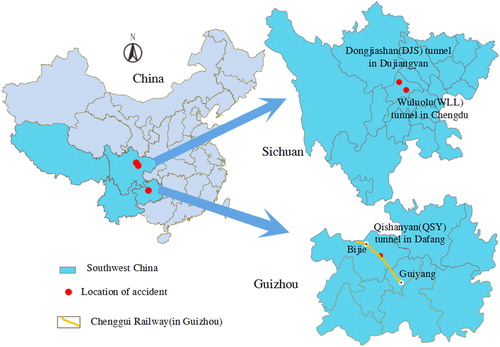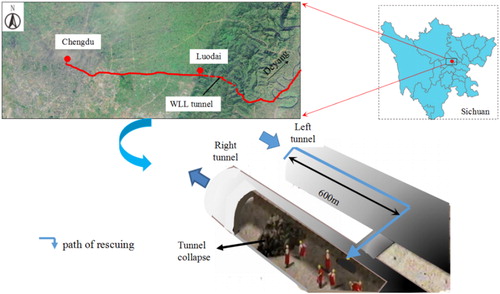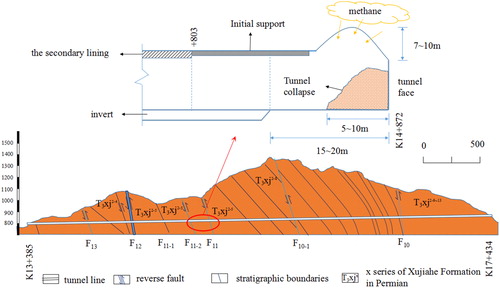Abstract
This Express Letter reports three methane explosion accidents during tunnel construction in Southwest China. In recent years, tunnel construction of China is developing rapidly. The geological conditions of the tunnel passing through are extremely complex, especially, tunnels in coal strata increase rapidly, what’s worse, many methane explosions occur during the tunnel construction. The backgrounds, causes and rescue operation of three methane explosion accidents situation are studied. Furthermore, we proposed relevant measures to prevent methane explosions of tunnels.
1. Introduction
Chinese tunnel boom shows no sign of abating. So far, the total length of tunnels (Railways and highways) has been about 30,000 km and 29,600 km, a mounting number of tunnels have been built in complex geological conditions (Lai et al. Citation2016a, Citation2016b, Citation2016c; Qiu et al. Citation2017; Li et al. Citation2018a, Citation2018b; Yan et al. Citation2018; Yu et al. Citation2019). The methane explosion accidents of tunnel construction in coal strata often cause great losses to people’s lives and property. For instance, a methane explosion occurred inside the excavation chamber of an EPB-TBM in Silivri–Istanbulin Europe, which caused 10 people injured in varying degrees and delayed duration for nearly two months. The similar accident happened in Nosoud tunnel in IRAN, etc. Statistical analyses of the typical methane explosion accidents occurring in various countries were made and information of methane emission should be included in geotechnical baseline report (Hanifi et al. Citation2012; Kang et al. Citation2013; Morsali and Rezaei Citation2017; Qiao et al. Citation2018a, Citation2018b). According to statistics, more than 100 methane tunnels have been built in China since 2005, and China has gained rich experience in the design, construction and operation management of methane tunnels (Lai et al. Citation2017, Citation2018a, Citation2018b; Zhang et al. Citation2018, Citation2019a, Citation2019b; Qiu et al. Citation2018a, Citation2018b, Citation2018c, Citation2019). However, during the construction period, due to careless management and pursuing construction progress, methane explosion accidents happen frequently, and have caused significant property damage and casualties. The present article reviews three typical methane accidents of tunnels in SW China, namely QSY tunnel, WLL tunnel and DJS tunnel (). To cause sufficient attention of the designers, construction companies and managers, further analyses of the causes, rescue measures of the methane explosion accidents are proposed, and some suggestions are put forward to ensure the safety of tunnel construction in the area of coal seam.
2. Case history
2.1. QSY tunnel
QSY tunnel was located in Dafang County, Guizhou Province, with the length of 2.548 km, which was the key tunnel for the safe management of the Chengdu-Guiyang Expressway (). Liulong Town which QSY tunnel located in was one of the important coal producing areas in Guizhou Province. The geological conditions of the tunnel passing through which contained karst, goaf and groundwater. The length of the tunnel passing through the coal layer was 665 m. Additionally, gas outburst, water and mud inrush occurred from time to time during tunnel construction.
At 2.50pm on 2 May 2017, a methane explosion occurred in QSY tunnel. The tremendous force caused serious collapse in the tunnel, and the position of the collapse was about 700 m away from the entrance, caused no electricity and poor visibility in the tunnel and brought great difficulties to the rescue operation, and 12 workers were trapped in the tunnel (). After the explosion, the methane concentration at the scene was still high; there might still be secondary explosion.
Rescue operation: After receiving the notice of rescue, the rescue team immediately dispatched 10 command vehicles, 2 professional rescue tool cars, 35 tunnel professional rescue personnels (). They were divided into three ambulance corps and an injured person was quickly rushed to hospital for medical treatment at 6.30pm. Three teams rotated to search and rescue trapped workers and two trapped personnels were rescued at about 10.30pm and 11.30pm, respectively. At 4.45am on 3rd May, after about 14 hours of search and rescue, the rescue mission was completed. The other four workers on moulding board-typed bench machine were successfully rescued ().The number of casualties was 12 deaths and 12 injuries.
Figure 3. Disaster situation of QSY tunnel: (a) Coal strata where QSY tunnel. Sources: http://dsb.gzdsw.com; (b) Tunnel portal after accident. Sources: http://hnrb.hinews.cn; (c) Rescue operation. Sources: http://www.chinanews.com; (d) Rescue vehicle. Sources: http://www.chinanews.com; (e) Rescue operation. Sources: http://www.chinanews.com; (f) Rescue operation. Sources: http://www.chinanews.com

Causes of the accident: (1) Safety training for tunnel construction and management personnel was not in place. The relevant enterprises were not aware of the high risk of methane tunnels. (2) The advance detection of methane in coal seam was not done well in the tunnel, and the corresponding methane concentration detector was not installed in the tunnel. (3) There was no emergency plan for methane emission and gas explosion in the tunnel. Meanwhile the cumulative length of tunnel construction reached about 2.4 km and 100 m remained incomplete. Constructors were so eager to complete the tunnel that they speeded up tunnelling and neglected methane detection.
2.2. WLL tunnel
The East extension line of Chengdu–Luodai Fast Track, a total length of 11.056km, connected Chengdu City and Deyang City. WWL tunnel, 2.915 km long, was the important part of the track and the tunnel passed through the shallow methane enrichment area. The left and right tunnels simultaneously excavated, and excavated 900 m and 895 m, respectively, until the Spring Festival holiday on 13 February 2015.
The site leader cut off the power supply and stopped ventilation in the tunnel during the Spring Festival holiday period. At about 1.10am on 24 February, four workers crossed the fence and went into the right tunnel, 20 minutes later, a violent explosion occurred in the tunnel. According to site investigation and analysis, the explosion site was located between 582 m and 588 m from the entrance of right tunnel and the explosion resulted in tunnel collapse which added difficulties to the rescue operation. The detonation flame spread rapidly though the methane layer and accumulated along the top of the tunnel. The shock wave produced by the explosion impacted outwards with the 30 degree angle of the entrance of the tunnel, which caused the houses, facilities and equipment damaged within the radius of 200 m ().
Rescue operation: As soon as the accident happened, the departments concerned quickly mobilized rescue teams of more than 110 professionals, carrying three search dogs and rescue equipment. Gas monitoring, personnel search and rescue work were carried out by three batches. The tunnel was blocked to prevent unauthorized personnel from entering the tunnel. The explosion caused the collapse of the right tunnel, and many construction machines heaped up in the tunnel, and the entire road into the tunnel was blocked, so that the difficulty of search and rescue increased.
So first of all, rescue teams eliminated the danger of the left tunnel and laid ventilation ducts into it. Then, fresh air was sent through the contact channel to the right tunnel to reduce methane concentration at the right tunnel. Next, the danger of the right tunnel was eliminated and victims inside the tunnel were searched (). Lastly, the explosion area within certain region was investigated (). This explosion accident resulted in seven deaths and 19 injuries to varying degrees.
Figure 5. Disaster situation of WWL tunnel: (a) The smoke rising from the explosion. Sources: http://image.baidu.com; (b) Scene of the explosion. Sources: http://www.bjd.com.cn; (c) Machines destroyed by an explosion. Sources: http://www.bjd.com.cn; (d) Houses destroyed by an explosion. Sources: http://e.chengdu.cn; (e) Prepared emergency equipment. Sources: http://news.youth.cn; (f) Rescue scene. Sources: http://www.chinanews.com.
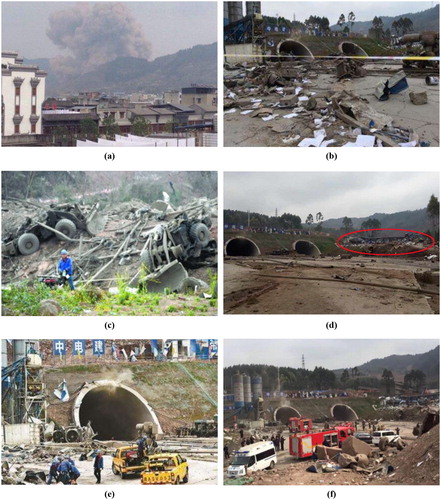
Causes of the accident: (1) During the Spring Festival period, the tunnel ventilation machines stopped running and the methane was still outbursting, which led to the methane concentration and reached the explosion limit. However, the alarm of methane detection equipment has not attracted the attention of the relevant personnel. On 24th February, four operators of slag carriers on the site surmounted the fence to overhaul vehicle in the right tunnel. Because of the action against the rules of the safety operation, sparks were created to detonate gas in the tunnel and caused the accident. (2) After the investigation of the accident, it could be found that the supervision of the relevant responsible companies was not in place, and the safety management of the scene has not been strengthened. Education and training for operators were not well in place, and safety education and technical clarification was not turned over to the workers remaining.
2.3. DJS tunnel
DJS tunnel was located in Dujiangyan City, Sichuan Province, which was one of the key engineering from Dujiangyan to Wenchuan (). The left tunnel was 4.111 km long and the right tunnel was 4.081 km long. The geological conditions where DJS tunnel lied was complex and many faults passed through. Additionally, there were abundant joints and fissures. Under the influence of crustal stress control and geological conditions, methane could be stored in the karst caves and fissures in a high pressure.
At 2.40pm on 22 December 2005, a particularly serious methane explosion occurred in the right tunnel, which resulted in 44 deaths, 11 injuries and direct economic losses of $20 million 350 thousand. The collapse has already occurred at the top of the right tunnel face in early December. Because the rock mass was in the core of the anticline where fissures developed and there existed a great deal of methane in the fissure, the collapse led to a great outburst of methane (). A worker was thrown to 168 m outside by the shock wave of the explosion. Many vehicles in the tunnel were seriously deformed by the impact of high pressure shock wave. A formwork trolley weighing about 70t outside the tunnel entrance had serious deformation and occurred the linear displacement of 47 m under the influence of shock wave (). DJS tunnel methane explosion was the most serious accident in the history of tunnel construction of China.
Figure 7. Disaster situation of DJS tunnel: (a) Tunnel portal. Sources: http://www.xinhua.org/; (b) Template trolley impacted by explosion. Sources: (c) Damaged truck. Sources: http://www.xinhua.org/; (d) Damaged truck. Sources: http://www.xinhua.org/; (e) Set cordon. Sources: http://www.xinhuanet.com/; (f) Rescue vehicle. Sources: http://fzsb.hinews.cn/.
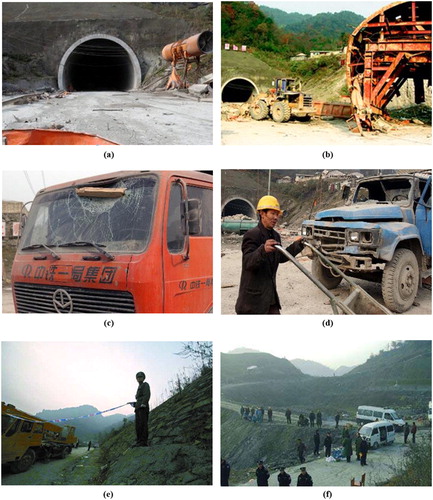
Rescue operation: After the accident, police officers and soldiers were guarding the scene, and established the warning line to prevent excessive methane concentration and secondary explosion. More than 70 rescuers rushed to the scene to start rescuing. Continuous search was carried out in and around the tunnel. On the morning of 23 December, the 42 deceased were found sequentially. On the morning of 24 December, the search and rescue work was over after the last two victims have been found (). The death toll in this accident rose to 44.
Causes of the accident: (1) There was no automatic detection and alarm device for electric equipment in high concentration methane tunnel. Methane effused abnormally because of the collapse at the top of tunnel face. The methane concentration near the template trolley reached the explosion limit and the spark resulted from short circuit of the plug near the plate distributor caused the explosion. (2) Labor services were farmed out to non-qualified operation teams. At the same time, safety training for tunnel workers was not in place. The problem of disordered management in construction, situation of undocumented inductions and rough quality checks has been not yet resolved. (3) The methane concentration was detected too high during construction, but the effective measures were not taken. Methane consistency was often out of gauge by the lack of ventilation.
3. Conclusion
The aforementioned three cases show that, the human factor is the principal aspect in these methane explosions. On one hand, the qualities of workers are uneven, and the construction operation has not been carried out as required. On the other hand, not enough attention has been paid to hidden dangers in difficult geology. Investigation and rectification work is neglected and construction progress is pursued blindly, which will increase the probability of accident.
To reduce the methane explosion disasters in the tunnels, we give the following advice, from the management perspective: (1) The relevant design requirements and specifications should be implemented and don’t pursue construction progress blindly. (2) Construction companies should strengthen the implementation of the safety education of construction workers. (3) Tunnel detection must be carried out strictly and ventilation facilities can operate normally to keep lower methane concentration (Kurnia et al. Citation2014; Luo et al. Citation2018; Liu et al. Citation2019a, Citation2019b). (4) Monitoring system should be equipped, strengthening rescue training and emergency drilling are also necessary. After the methane concentration exceeds the standard, the disaster relief work should be carried out in an orderly way.
From the technical perspective: (1) Construction ventilation facilities must be in place. It’s crucial to strengthen the ventilation technology of methane tunnel, so that the gas concentration in the tunnel can be maintained at a lower value (Pang et al. Citation2014a, Citation2014b; Ren et al. Citation2018a, Citation2018b, Citation2018c; Hu et al. Citation2019). (2) In advance geological prediction of the tunnel, the distribution of coal seam, the possible position of methane and the judgment of dangerous grade must be accurate. In the methane tunnels, safety training for construction and management personnel must be effective. During the construction of WWL tunnel, it was found repeatedly that the inspectors operated against the regulations (Ma et al. Citation2014; Nie et al. Citation2015; Wang et al. Citation2018a, Citation2018b, Citation2018c, Citation2018d, Wang and Sun, Citation2019). (3) In low concentration methane tunnel, methane detection equipment must be installed. In high concentration methane tunnel, methane detection equipment with functions of gas alarm over limit and automatic control of ventilator must be installed. The reliability of explosion-proof machinery and equipment should be valued, and methane detection equipment should be installed at the top of the tunnel. (4) Research on preventing gas outburst should be undertaken. At present, the method widely used is borehole drainage and a new type of methane drainage device could be developed on the basis of this method (Zhang et al. Citation2014, Citation2016; Fan et al. Citation2018). (5) Pay attention to the prevention and control of the collapse accident. The development of cracks in the rock mass forms a new permeable channel for gas migration. A new free surface is formed and the original rock pressure balance is destructed. Methane moves to the low pressure area, enter the tunnel space and accumulate in the cavity of the collapse. (6) Electrical equipment in high concentration methane tunnel should have short-circuit protection rather than exposing sparks to the air. Preventive techniques such as grouting, foam injection and sealed lining should be used for gassy outburst and water inflow (Duan et al. Citation2019; Zheng et al. Citation2019; Technical Code for Railway Tunnel with Gas (TB10120-2002) n.Citationd.).
Acknowledgments
The article was modified by Rodney Sheldon Garnes (University of the West Indies), whose native language is English. He helped us improve the English. Meanwhile the authors would like to thank the reviewers for helpful suggestions that allowed us to improve this article.
Disclosure statement
No potential conflict of interest was reported by the authors.
Additional information
Funding
References
- Duan LM, Yang T, Qin HY, Liu T. 2019. CATIA-based BIM Technology in Highway Tunnel Design. Adv Civ Eng. 2019: 6913895. doi:10.1155/2019/691389.
- Fan HB, Zhang YH, He SY, Wang K, Wang XL, Wang H. 2018. Hazards and treatment of karst tunnelling in Qinling-Daba mountainous area: overview and lessons learnt from Yichang-Wanzhou railway system. Environ Earth Sci. 77:679. doi:10.1007/s12665-018-7860-1.
- Hanifi C, Muammer C, Gunduz O, Nuh B. 2012. A case study on the methane explosion in the excavation chamber of an EPB-TBM and lessons learnt including some recent accidents. Tunn Undergr Sp Tech. 27(1):159–167. doi:10.1016/j.tust.2011.06.009.
- Hu Z, Du K, Lai JX, Xie YL. 2019. Statistical analysis of influence of cover depth on loess tunnel deformation in NW China. Adv Civ Eng. 2019:2706976. doi:10.1155/2019/2706976.
- Kang XB, Xu M, Luo S, Xia Q. 2013. Study on formation mechanism of gas tunnel in non-coal strata. Nat Hazards. 66(2):291–301. doi:10.1007/s11069-012-0484-y.
- Kurnia JC, Sasmito AP, Mujumdar AS. 2014. CFD simulation of methane dispersion and innovative methane management in underground mining faces. Appl Math Model. 38(14):3467–3484. doi:10.1016/j.apm.2013.11.067.
- Lai JX, Mao S, Qiu JL, Fan HB, Zhang Q, Hu ZN, Chen JX. 2016a. Investigation progresses and applications of fractional derivative model in geotechnical engineering. Math Probl Eng. 2016:9183296. doi:10.1155/2016/9183296.
- Lai JX, Qiu JL, Fan HB, Zhang Q, Hu ZN, Wang JB, Chen JX. 2016b. Fiber Bragg grating sensors-based in-situ monitoring and safety assessment of loess tunnel. J Sensors. 2016:8658290. doi:10.1155/2016/8658290.
- Lai JX, Wang KY, Qiu JL, Niu FY, Wang JB, Chen JX. 2016c. Vibration response characteristics of the cross tunnel structure. Shock Vib. 2016:9524206. doi:10.1155/2016/9524206.
- Lai JX, He SY, Qiu JL, Chen JX, Wang LX, Wang K, Wang JB. 2017. Characteristics of seismic disasters and aseismic measures of tunnels in Wenchuan earthquake. Environ Earth Sci. 76:94. doi:10.1007/s12665-017-6405-3.
- Lai JX, Wang XL, Qiu JL, Zhang GZ, Chen JX, Xie YL, Luo YB. 2018a. A state-of-the-art review of sustainable energy based freeze proof technology for cold-region tunnels in China. Renew Sust Energ Rev. 82:3554–3569. doi:10.1016/j.rser.2017.10.104.
- Lai JX, Wang XL, Qiu JL, Chen JX, Hu ZN. 2018b. Extreme deformation characteristics and countermeasures for a tunnel in difficult grounds in southern Shaanxi, China. Environ Earth Sci. 77:706. doi:10.1007/s12665-018-7888-2.
- Li YY, Xu SS, Liu HQ, Ma EL, Wang LX. 2018a. Displacement and stress characteristics of tunnel foundation in collapsible loess ground reinforced by jet grouting columns. Adv Civ Eng. 2018:2352174. doi:10.1155/2018/2352174.
- Li PF, Wang F, Fang Q. 2018b. Undrained analysis of ground reaction curves for deep tunnels in saturated ground considering the effect of ground reinforcement. Tunn Undergr Sp Tech. 71:579–590.
- Liu C, Fan Z, Chen X. 2019a. Experimental study on bond behavior between section steel and RAC under full replacement ratio. KSCE J Civ Eng.
- Liu C, Lv ZY, Zhu C. 2019b. Study on calculation method of long term deformation of RAC beam based on creep adjustment coefficient. KSCE J Civ Eng.
- Luo XL, Li D, Zhang SR. 2018. Traffic flow prediction in holidays based on DFT and SVR. J Sensors. 2018:6461450. doi:10.1155/2018/6461450.
- Ma QJ, Zhang Q, Pang L. 2014. Hazard effects of high-speed flow from methane-hydrogen premixed explosions. Proc Safety Prog. 33(1):85–93. doi:10.1002/prs.11625.
- Morsali M, Rezaei M. 2017. Assessment of H2S emission hazards into tunnels: the Nosoud tunnel case study from Iran. Environ Earth Sci. 76:227. doi:10.1007/s12665-017-6493-0.
- Nie BS, Wang C, Meng JQ, Xue F, Dai LC. 2015. Laboratory investigation into fractal characteristics of methane explosion flame. Proc Safety Prog. 34(3):244–249. doi:10.1002/prs.11713.
- Pang L, Wang T, Zhang Q, Ma QJ, Cheng L. 2014a. Nonlinear distribution characteristics of flame regions from methane–air explosions in coal tunnels. Process Saf Environ. 92(3):193–198. doi:10.1016/j.psep.2012.10.016.
- Pang L, Zhang Q, Lin DC. 2014b. Numerical analysis of characteristics of the wind caused by methane-air explosion. Eng Computation. 31(3):490–500. doi:10.1108/EC-12-2011-0161.
- Qiao RJ, Shao ZS, Wei W, Zhang Y. 2018a. Theoretical investigation into the thermo-mechanical behaviours of tunnel lining during RABT fire development. Arab J Sci Eng. doi:10.1007/s13369-018-3555-x.
- Qiao RJ, Shao ZS, Liu FY, Wei W. 2018b. Damage evolution and safety assessment of tunnel lining subjected to long-duration fire. Tunn Undergr Sp Tech. 83:354–363. doi:10.1016/j.tust.2018.09.036.
- Qiu JL, Wang XL, He SY, Liu HQ, Lai JX, Wang LX. 2017. The Catastrophic Landside in Maoxian County, Sichuan, SW China on June 24, 2017. 89:1485-1493. Nat Hazards. 89(3):1485. doi:10.1007/s11069-017-3026-9.
- Qiu JL, Liu HQ, Lai JX, Lai HP, Chen JX, Wang K. 2018a. Investigating the long term settlement of a tunnel built over improved loessial foundation soil using jet grouting technique. J Perform Constr Fac. 32(5):1–15, Article ID 04018066. doi:10.1061/(ASCE)CF.1943-5509.0001155.
- Qiu JL, Wang XL, Lai JX, Zhang Q, Wang JB. 2018b. Response characteristics and preventions for seismic subsidence of loess in Northwest China. Nat Hazards. 92(3):1909–1935. doi:10.1007/s11069-018-3272-5.
- Qiu JL, Qin YW, Lai JX. 2018c. Structural response of the metro tunnel under local dynamic water environment in loess strata. Geofluids. 2019, Article ID 854195. doi:10.1155/2019/8541959
- Qiu J, Yang T, Wang X, Zhang G. 2019. Review of the flame retardancy on highway tunnel asphalt pavement. Construction and Building Materials. in press. doi:10.1016/j.conbuildmat.2018.11.034.
- Ren R, Xu S, Ren Z, Zhang S, Wang H, Wang X, He S. 2018a. Numerical Investigation of Particle Concentration Distribution Characteristics in Twin-tunnel Complementary Ventilation System. Math Probl Eng. 2018:1–13. doi:10.1155/2018/29187.
- Ren R, Zhou H, Hu Z, He SY, Wang XL. 2018b. Statistical analysis of fire accidents in Chinese highway tunnels 2000–2016. Tunn Undergr Sp Tech. 83:452–460. doi:10.1016/j.tust.2018.10.008.
- Ren R, Yu DQ, Wang LX. 2018c. Typhoon triggered operation tunnel debris flow disaster in coastal areas of SE China. Geomat Nat Haz Risk. doi:10.1080/19475705.2018.1535452.
- Technical Code for Railway Tunnel with Gas (TB10120-2002) (n.d.) (in Chinese).
- Wang JB, Song ZP, Zhao BY, Liu XR, Liu J, Lai JX. 2018a. A study on the mechanical behavior and statistical damage constitutive model of sandstone. Arab J Sci Eng. 43(10):5179–5192. doi:10.1007/s13369-017-3016-y.
- Wang QP, Sun H. 2019. Traffic structure optimization in historic districts based on green transportation and sustainable development concept. Adv Civ Eng. 2019: 9196263. doi:10.1155/2019/9196263.
- Wang ZC, Hu Z, Lai JX. 2018b. Settlement characteristics of jacked box tunneling underneath a highway embankment. J Perform Constr Fac. doi:10.1061/(ASCE)CF.1943-5509.0001269.
- Wang ZF, Cheng WC, Wang YQ. 2018c. Investigation into Geohazards during Urbanization Process of Xi’an, China. Nat Hazards. 92(3):1937–1953.
- Wang ZF, Shen SL, Cheng WC, Arulrajah A. 2018d. Simple method to predict ground displacements caused by installing horizontal jet-grouting columns. Math Probl Eng. 2018:1897394. doi:10.1155/2018/1897394.
- Yan QX, Zhang WL, Zhang C, Chen H. 2018. Back analysis of water and earth loads on shield tunnel and structure ultimate limit state assessment: a case study. Arab J Sci Eng. doi:10.1007/s13369-018-3569-4.
- Yu HT, Cai C, Bobet A, Zhao X, Yuan Y. 2019. Analytical solution for longitudinal bending stiffness of shield tunnels. Tunn Undergr Sp Tech. 83:27–34.
- Zhang B, Bai CH, Xiu GL, Liu QM, Gong GD. 2014. Explosion and flame characteristics of methane/air mixtures in a large-scale vessel. Proc Safety Prog. 33(4):362–368. doi:10.1002/prs.11670.
- Zhang K, Wang Z, Jiang J, Sun W, You M. 2016. Effect of pipe length on methane explosion in interconnected vessels. Proc Safety Prog. 35(3):241–247. doi:10.1002/prs.11819.
- Zhang ZQ, Zhang H, Tan YT, Yang HY. 2018. Natural wind utilization in the vertical shaft of a super-long highway tunnel and its energy saving effect Author links open overlay pane. Build Environ. 145:140–152.
- Zhang YW, Weng XL, Song ZP, Sun YF. 2019a. Modeling of loess soaking induced impacts on metro tunnel using water soaking system in centrifuge. Geofluids. 2019: 5487952. doi:10.1155/2019/5487952.
- Zhang YW, Song ZP, Weng XL, Xie YL. 2019b. A new soil-water characteristic curve model for unsaturated loess based on wetting-induced pore deformation. Geofluids. 2019: 5261985. doi:10.1155/2019/5261985.
- Zheng YC, Liu K, Fang Y. 2019. Rockburst Prediction Model Based on Entropy Weight Integrated with Grey Relational-BP Neural Network. Adv Civ Eng. 2019: 3453614. doi:10.1155/2019/3453614.

